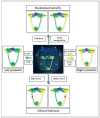Zebrafish Tools for Deciphering Habenular Network-Linked Mental Disorders
- PMID: 33672636
- PMCID: PMC7924194
- DOI: 10.3390/biom11020324
Zebrafish Tools for Deciphering Habenular Network-Linked Mental Disorders
Abstract
The prevalence of patients suffering from mental disorders is substantially increasing in recent years and represents a major burden to society. The underlying causes and neuronal circuits affected are complex and difficult to unravel. Frequent disorders such as depression, schizophrenia, autism, and bipolar disorder share links to the habenular neural circuit. This conserved neurotransmitter system relays cognitive information between different brain areas steering behaviors ranging from fear and anxiety to reward, sleep, and social behaviors. Advances in the field using the zebrafish model organism have uncovered major genetic mechanisms underlying the formation of the habenular neural circuit. Some of the identified genes involved in regulating Wnt/beta-catenin signaling have previously been suggested as risk genes of human mental disorders. Hence, these studies on habenular genetics contribute to a better understanding of brain diseases. We are here summarizing how the gained knowledge on the mechanisms underlying habenular neural circuit development can be used to introduce defined manipulations into the system to study the functional behavioral consequences. We further give an overview of existing behavior assays to address phenotypes related to mental disorders and critically discuss the power but also the limits of the zebrafish model for identifying suitable targets to develop therapies.
Keywords: Wnt; asymmetry; behavior; compound; habenula; mental disorder; neurogenesis; pharmacology; zebrafish.
Conflict of interest statement
The authors declare no conflict of interest. The funders had no role in the design of the study; in the collection, analyses, or interpretation of data; in the writing of the manuscript, or in the decision to publish the results.
Figures

References
Publication types
MeSH terms
Substances
Grants and funding
LinkOut - more resources
Full Text Sources
Other Literature Sources
Medical
Research Materials

